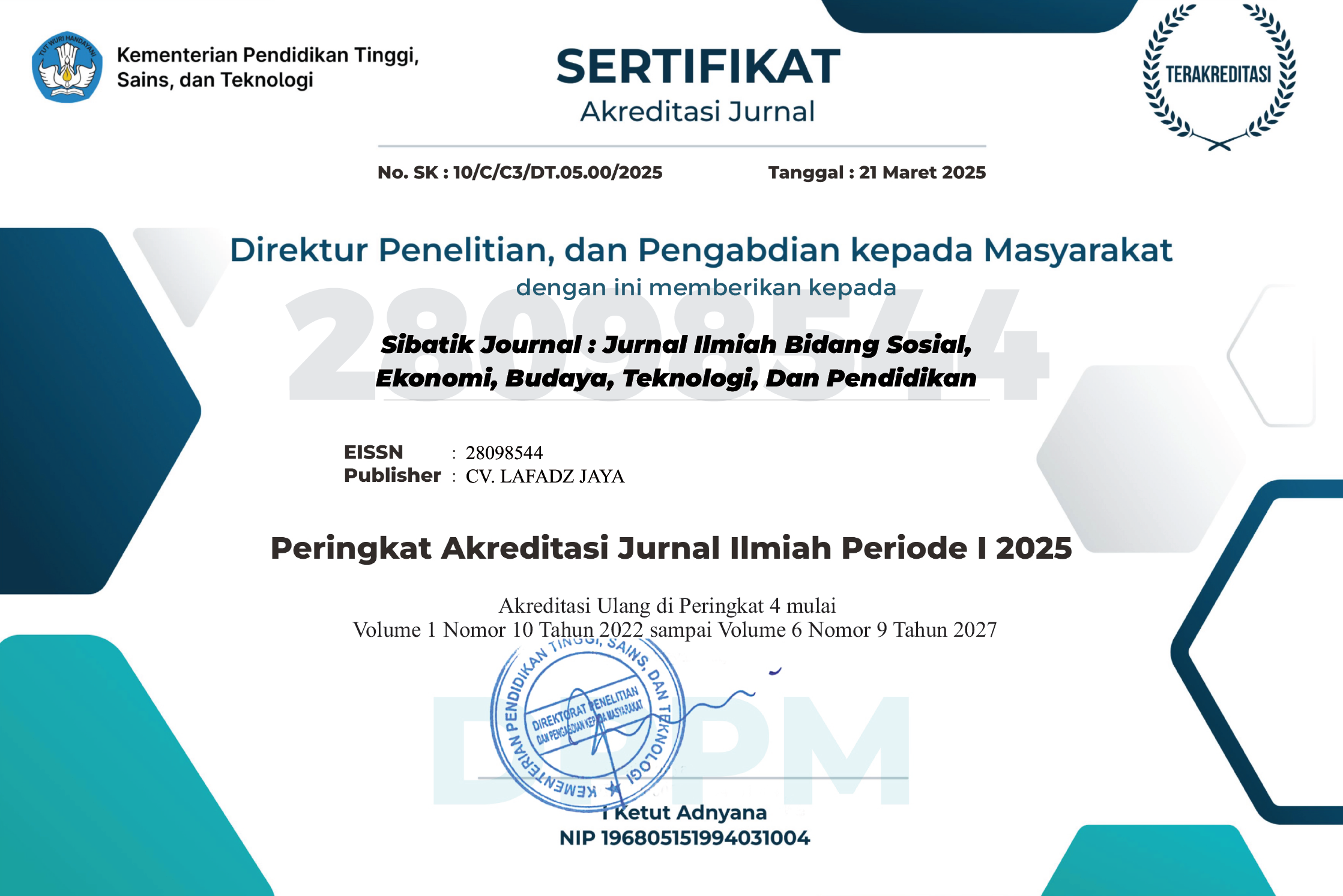PERAN MEDIA SOSIAL DALAM PEMBENTUKAN PERILAKU REMAJA
Main Article Content
Mhd Tafsir Tambunan
Siti Rahma Harahap
Mulkan Derajat Silaen
The role of social media in shaping adolescent behavior is an important issue to be studied in the context of current developments in communication technology. The purpose of this study is to analyze the positive and negative impacts of social media on adolescent behavior, as well as to understand the factors that influence the use of these platforms. The approach used is Virtual Ethnography, which allows observation of adolescent interaction behavior in cyberspace. The results of the study indicate that social media can increase access to information, creativity, and communication skills, but also has the potential to cause addiction, decreased mental health, and cyberbullying. Therefore, understanding the role of social media is very important for parents, educators, and policy makers to create an environment that supports positive adolescent growth in the digital world. This study is expected to provide useful insights in managing the use of social media among adolescents, so as to maximize the benefits obtained while minimizing the risks.
Allport, G. W. (1961). Pattern and Growth in Personality. New York: Holt, Rinehart, and Winston.
Anderson, M., & Jiang, J. (2018). "Teens, Social Media & Technology 2018." Pew Research Center.
Andreassen, C. S., Torsheim, T., Brunborg, G. S., & Pallesen, S. (2012). "Development of a Facebook addiction scale." Psychological Reports, 110(2), 501-517
Ari Athiutama, Ridwan, Indra Febriani, Imelda Erman, Aldella Trulianty, Jurnal Keperawatan Raflesia, Penggunaan Media Sosial Dan Kualitas Tidur Pada Remaja, Jurnal Keperawatan Raflesia, Volume 5 Nomor 1, Mei 2023,h,10
Bandura, A. (1986). Social Foundations of Thought and Action: A Social Cognitive Theory. Englewood Cliffs, NJ: Prentice-Hall.
Binus university, (2020)Metode Etnografi Virtual: Tren dalam Penelitian Media Sosial,
Boyd, D. & Ellison, N. (2008). "Social Network Sites: Definition, History, and Scholarship." Journal of Computer-Mediated Communication, 13(1), 210-230.
Boyd, D. (2014). It's Complicated: The Social Lives of Networked Teens. Yale University Press
Castells, M. (2012). Networks of Outrage and Hope: Social Movements in the Internet Age. Polity Press.
Chou, H. T. G., & Edge, N. (2012). "They are happier and having better lives than I am: The impact of using Facebook on perceptions of others' lives." Cyberpsychology, Behavior, and Social Networking, 15(2), 117-121
Common Sense Media. (2018). Social Media, Social Life: Teens Reveal Their Experiences
De Veirman, M., Cauberghe, V., & Hudders, L. (2017). "Marketing through Instagram influencers: Impact of number of followers and product divergence on brand attitude." International Journal of Advertising, 36(5), 798-828.
De Veirman, M., Cauberghe, V., & Hudders, L. (2017). "Marketing through Instagram influencers: Impact of number of followers and product divergence on brand attitude." International Journal of Advertising, 36(5), 798-828.
Erikson, E. H. (1968). Identity: Youth and Crisis. New York: W.W. Norton & Company.
Green, L. W., & Kreuter, M. W. (1999). Health Promotion Planning: An Educational and Ecological Approach. McGraw-Hill.
Harris, T. (2019). "The Social Dilemma." Netflix Documentary
Hinduja, S., & Patchin, J. W. (2018). "Connecting Adolescent Suicide to the Severity of Bullying and Cyberbullying." Journal of School Violence, 17(4), 302-315.
Hinduja, S., & Patchin, J. W. (2018). Bullying beyond the schoolyard: Preventing and responding to cyberbullying. Corwin Press.
Hinduja, S., & Patchin, J. W. (2018). Cyberbullying: Identification, Prevention, and Response. Corwin Press
https://digitalmama.id/2022, otret Cyberbullying pada Anak dan Remaja di Indonesia, di akses 13-03-2025
Lenhart, A., Smith, A., Anderson, M., Duggan, M., & Perrin, A. (2015). Teens, Technology & Friendships. Pew Research Center
Livingstone, S., & Helsper, E. J. (2007). "Gradations in Digital Inclusion: Children, Young People, and the Digital Divide," New Media & Society, 9(4), 671-696.
Livingstone, S., & Helsper, E. J. (2007). "Gradations in digital inclusion: Children, young people, and the digital divide," New Media & Society, 9(4), 671-696.
Montag, C., Lachmann, B., Herrlich, M., & Zweig, K. (2019). "Addictive Features of Social Media/Messaging Platforms and Freemium Games against the Background of Psychological and Economic Theories." International Journal of Environmental Research and Public Health, 16(14), 2612.
Nasution, F., & Rahmawati, D. (2021). "Dampak Media Sosial terhadap Perilaku Remaja: Studi Literatur," Jurnal Psikologi dan Sosial Budaya, 7(2), 112-124.
Nasution, F., & Rahmawati, D. (2021). "Dampak Media Sosial terhadap Perilaku Remaja: Studi Literatur," Jurnal Psikologi dan Sosial Budaya, 7(2), 112-124.
Pew Research Center. (2018). Teens, Social Media & Technology 2018. Washington, DC.
Przybylski, A. K., Murayama, K., DeHaan, C. R., & Gladwell, V. (2013). "Motivational, emotional, and behavioral correlates of fear of missing out." Computers in Human Behavior, 29(4), 1841-1848.
Rideout, V. J., & Fox, S. (2018). Digital Learning: The Role of Media in Teen Education. Common Sense Media
Ridley Sirait, Palupi Triwahyuni, Hubungan Penggunaan Media Sosial dengan Kualitas Tidur Mahasiswa Akademi Keperawatan Surya Nusantara , INNOVATIVE: Journal Of Social Science Research Volume 4 Nomor 3 Tahun 2024 Page 541-555, h,4-8
Santrock, J. W. (2021). Adolescence. New York: McGraw-Hill Education
Sarwono, S. W. (2002). Psikologi Sosial. Jakarta: Rajawali Pers
Skinner, B. F. (1953). Science and Human Behavior. New York: Macmillan
Turkle, S. (2011). Alone Together: Why We Expect More from Technology and Less from Each Other. Basic Books.
Twenge, J. M. (2017). iGen: Why Today's Super-Connected Kids Are Growing Up Less Rebellious, More Tolerant, Less Happy—and Completely Unprepared for Adulthood. Simon & Schuster
Twenge, J. M., Joiner, T. E., Rogers, M. L., & Martin, G. N. (2018). "Increases in depressive symptoms, suicide-related outcomes, and suicide rates among U.S. adolescents after 2010 and links to increased new media screen time." Clinical Psychological Science, 6(1), 3-17.
Vosoughi, S., Roy, D., & Aral, S. (2018). "The spread of true and false news online." Science, 359(6380), 1146-1151
Wardle, C., & Derakhshan, H. (2017). "Information Disorder: Toward an Interdisciplinary Framework for Research and Policy Making." Council of Europe.
We Are Social & Hootsuite. (2023). Digital 2023: Indonesia Report
Weber, M. (1922). Economy and Society: An Outline of Interpretive Sociology. University of California Press
World Health Organization (WHO). (2018). Adolescents: Health Risks and Solutions. Diakses dari https://www.who.int/news-room/fact-sheets/detail/adolescents-health-risks-and-solutions

























